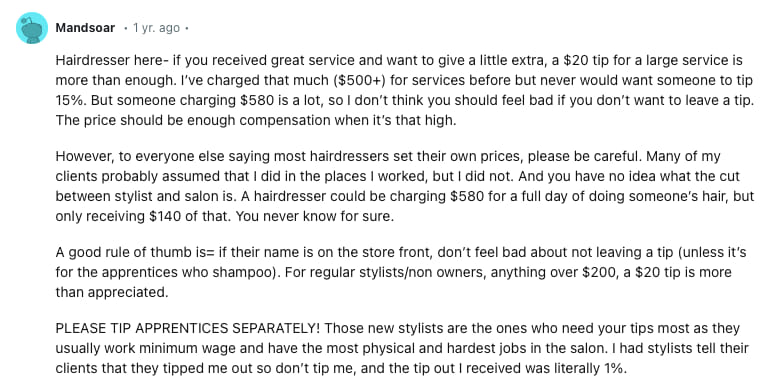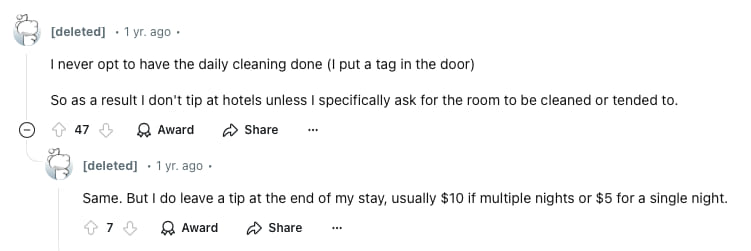Tipping is a common and expected practice in Canada, especially in service-related industries with a lower average minimum wage.
In Canada, you tip based on the quality of service with higher tips for exceptional experiences and lower for poor service. In restaurants, it’s standard to tip between 15–20% of the bill. For taxis, hair salons, delivery drivers, and hotel staff, a tip between 10–15% is typical.
Sometimes, gratuity is added automatically to your bill, so check carefully before potentially (and accidentally) doubling up on your tip.
Key Takeaways
- Canada is a tipping country, especially for restaurants, salons, and personal services.
- Table service tips are usually between 15-20% of the bill.
- Delivery drivers and personal service workers are usually tipped between 10-15%.
Do you tip in Canada?
In Canada, tipping culture is an important and expected part of many service industry transactions. The standard tip range in Canada is between 10 to 20% of the total bill, depending on the service provided.
While tipping is not mandatory in Canada, it is common practice to show appreciation for good service with tips.
Tipping culture can vary by region and service type, but it's always a way to acknowledge quality service and help support workers who rely on tips for income.
Be aware that gratuity is sometimes automatically added to your bill if you have a large group or if you’re at a high-end restaurant.
How much to tip in Canada
The average tip in Canada is 15–20% at restaurants and 10–15% for services like taxis and hair salons. The exact amount can vary depending on the service quality and situation.
Tipping in restaurants in Canada
Tipping in restaurants in Canada varies depending on the service type:
Full-service restaurants: Tip 15-20% of the total bill based on service quality.
- Good service (15 to 20%): Attentive, friendly, and timely
- Normal service (15%): Adequate but not exceptional
Takeout: Tips are not expected, but $1–$3 is appreciated for extra service or large orders.
Cafes: Tip 10–15% if you receive table service.
When giving a tip at a restaurant, you can either tip with cash or card.
To tip with cash, leave money on the table or hand it directly to the server. For small orders when you’re speaking directly with a barista, you can tip in the tip jar at the counter.
To tip with a card, select a percentage or dollar amount when you get a tip prompt before paying.
How much to tip hairdressers and other personal services in Canada
In Canada, it is customary and appreciated to tip hairdressers as well as other people who provide personal services, such as manicurists and massage therapists. These professionals rely on tips as part of their income.
Hairdressers and barbers: Tip 10–20% of the total service cost, depending on the quality of service. Even at low-end salons, a tip of $5–$10 is appreciated for good service.
Other personal services: Tip 10–15% for good service. For manicurists, tip $2–$5 for basic services with higher tips for complex treatments.
Always tip directly after the service, either in cash or by adding it to your bill if paying with a card.
Here are some takes from real Canadians on tipping at hair salons:


How much to tip taxi and Uber drivers in Canada
In Canada, tipping taxi and Uber drivers is customary but not mandatory.
The standard tip is 10–15% of the fare, depending on the service quality and whether they assist you with luggage. For short rides or small fares, a $2–$5 tip is appreciated.
With Uber, add your tip using the app after the ride.
With taxis, either tip in cash or add the tip to your card payment. It’s convenient to round up for convenience, especially if you’re paying a small fare with cash.
Card vs: cash: Some taxi and Uber drivers in Canada may prefer or even require payment through credit or debit cards, especially in larger cities. It's always a good idea to confirm payment methods before your ride begins, particularly if you're relying on cash.
Here are some personal takes from Canadians on tipping taxi and Uber drivers:


How much to tip hotel staff in Canada
In Canada, tipping hotel staff is customary but varies depending on the service.
Housekeeping: Tip $2–$5 per night and leave the money daily, as different staff may clean your room each day. Put it in an envelope or leave a note each day so it’s clear the money is for them.
Bellhops: Tip $1–$2 per bag and hand the money directly to the staff member.
Concierge: Tip $5–$20 based on the service provided, such as booking tickets or arranging tours. It’s helpful to leave a note with the tip to specify the service.
The amount you tip can vary depending on the quality of service and the hotel's location. Higher-end hotels and popular tourist areas may expect higher tips, but tips are always appreciated across Canada.
Here are some opinions on how to handle tipping hotel staff in Canada:


What happens if you don’t tip in Canada?
In Canada, not tipping is not illegal – but you may be seen as rude or disrespectful.
If you don’t tip, it may affect the quality of service you receive in the future, as tipping is tied to appreciation for service. In some cases, not tipping could also lead to negative perceptions from staff or other customers.
Tipping is a core part of Canadian culture, especially for workers in service industries that rely on tips to supplement their wages. This includes waitstaff, taxi drivers, hotel staff, and manicurists. It is not appropriate to tip medical professionals, government workers, or high-end professionals.
If you're unsure, check if a service charge is included in your bill, as this often happens in group settings. If you truly can’t afford to tip a service worker, leave a kind note or simply round up your bill.
What to do if you get a tip prompt when you don’t expect it
Tip prompts are becoming more common in Canada, even in unexpected situations like purchasing a wedding dress.
With an unexpected tip prompt, consider the level of service provided.
If the service was basic, like making a straightforward sale, you may politely decline or choose a smaller tip.
If the service went above and beyond, such as offering personalized attention, customization, or going the extra mile, leaving a tip of 10-15% may be appropriate. And, of course, only tip in these uncommon scenarios if you can afford.
Tipping in Canada vs. the U.S.
While tipping cultures in both Canada and the U.S. are similar, there are notable differences to be aware of.
Similarities between Canada and the US in tipping culture:
- Tipping 15-20% at restaurants
- Tipping for hotel staff, taxi drivers, hairdressers, and other personal services
- Tipping is optional but appreciated
Here are some differences in tipping culture between Canada and the US:
- Tips in Canada tend to be slightly lower (around 15%) while in the US, 20% is closer to standard.
- Canadian service workers typically earn a higher base wage, whereas US minimum wage workers tend to earn less (making tips more essential).
- Many Canadian restaurants add automatic service charges for large groups, which cuts the need for additional tips.
- Tipping is less heavily emphasized in Canada compared to the US.
FAQ
Do you tip tattoo artists in Canada?
It’s common to tip tattoo artists between 10 and 15% of the total tattoo cost. Choose an amount that reflects the complexity of the design and the personal attention of the artist. Tip at the end, with cash or card.
Are tips taxed in Canada?
Yes, tips are taxable in Canada and people who earn tips must report them on their tax returns as taxable income. That’s true whether the tips were cash or added to the bill.
How much should a server claim in tips Canada?
Servers must report 100% of their tips in Canada. There is something called "declared tips" which is a simplified form of tips reporting, meant to represent the average estimated 10% of sales that servers earn in tips.















 $25 GeniusCash + Total of $60 off your first four orders + free delivery (Eligible for New Customers in ON and QC only)
$25 GeniusCash + Total of $60 off your first four orders + free delivery (Eligible for New Customers in ON and QC only)








































Leave a comment
Comments
I agree with almost everything you said except the "under minimum wage" and "no one would eat out" arguments.
In fact, in most of the country including where I'm from, minimum wage is the same for servers as it is for every other worker:
https://www.restaurantscanada.org/minimum-wage-by-province/
I'm certain people would still eat out if food prices were raised across the board. People eat out for the convenience and pleasure of eating out, not because of a slight difference in price. Tipping is just an extra hassle for everyone involved, and I don't like hassles. It has nothing to do with me being cheap. The fact that we have to put so much thought into the difference between hairdressers, servers, customer service reps, the dentist, and any other industry just proves my point.
I would argue it is more shameful how you just spoke to Judy than her not paying a full 20% tip on her visit to the hairdresser.
Don't you think the hairdresser is being paid for her job and time? I'm not sure what makes service work that much more special than any other job. There are so many jobs out there that involve direct interaction with the customer and they get no tips at all.
I tip 15% at restaurants (usually on top of tax) and other places where tips are common it's usually around 10% but more discretionary. I do it because it has become the custom here in Canada. However, if someone is making a fair wage for the work they do then IMO tips should be completely optional.
I agree with the sentiment that all employees be paid a fair wage that is at least minimum wage and hopefully more and that the price of everything be higher to compensate.
Service is a job like any other and part of that job is to provide good service regardless of tip. It would just make the whole process much smoother for everyone involved.